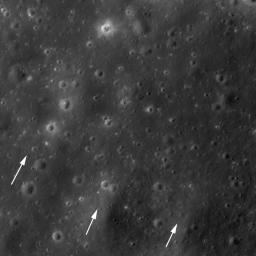
|
Ejecta from Copernicus
- Click the image above for a larger view
- Full-Res JPEG (1000 x 1000) (96.3 kB)
- Full-Res TIFF (1000 x 1000) (1.0 MB)
Caption:
One of the geologic features that makes Copernicus crater special is its extensive, high-reflectance ejecta rays that extend across nearby mare and superpose (overlap) ejecta from other craters -- Copernican ejecta extends more than 500 km from the impact site. In this high-Sun image, albedo differences are enhanced and the arrows indicate several "fingers" of ejecta and the direction of ejecta emplacement (away from Copernicus, which is to the southwest). LROC NAC image M127050121L, image width is 470 meters (1541 feet).
Background Info:
NASA's Goddard Space Flight Center built and manages the mission for the Exploration Systems Mission Directorate at NASA Headquarters in Washington. The Lunar Reconnaissance Orbiter Camera was designed to acquire data for landing site certification and to conduct polar illumination studies and global mapping. Operated by Arizona State University, LROC consists of a pair of narrow-angle cameras (NAC) and a single wide-angle camera (WAC). The mission is expected to return over 70 terabytes of image data.
Cataloging Keywords:
| Name | Value | Additional Values |
|---|---|---|
| Target | Moon | |
| System | Earth | |
| Target Type | Satellite | |
| Mission | Lunar Reconnaissance Orbiter (LRO) | |
| Instrument Host | Lunar Reconnaissance Orbiter | |
| Host Type | Orbiter | |
| Instrument | Lunar Reconnaissance Orbiter Camera (NAC) | |
| Detector | Narrow Angle Camera (NAC), Wide Angle Camera (WAC) | |
| Extra Keywords | Crater, Grayscale, Impact | |
| Acquisition Date | ||
| Release Date | 2010-09-30 | |
| Date in Caption | ||
| Image Credit | NASA/GSFC/Arizona State University | |
| Source | photojournal.jpl.nasa.gov/catalog/PIA13526 | |
| Identifier | PIA13526 | |
